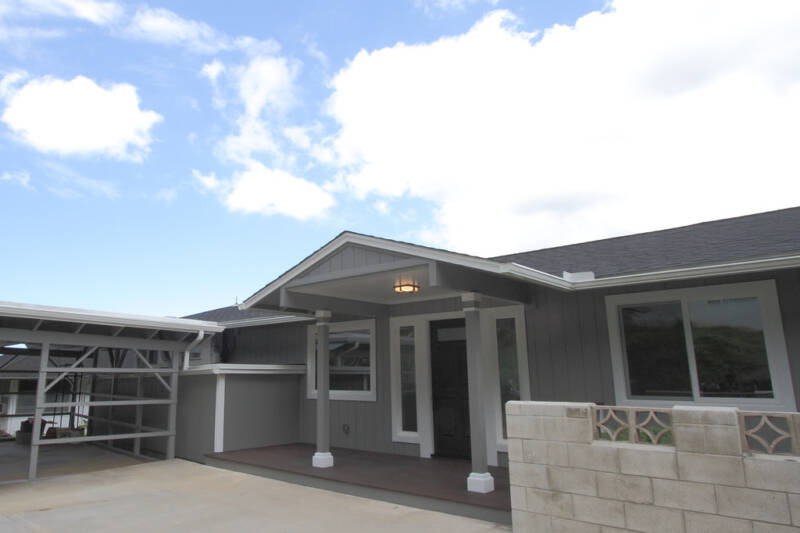
May 11, 2024 Homeworks Hawaii, Design
When building a house in Hawaii, one of the primary considerations is the choice of architectural design. Each style—two-story, split-level, and rambler—comes with its own set of cost implications. Two-story homes typically offer more living space per square foot of land, potentially making them more cost-effective in terms of land usage. However, building vertically often requires additional structural support, which can increase construction expenses. Split-level homes provide a compromise between space and cost, offering distinct living areas while minimizing the need for extensive excavation and foundation work. On the other hand, rambler-style homes, with their single-story layout, may require more land but can be simpler and more affordable to construct due to fewer structural complexities.
The Hawaiian islands aren’t very large, and with limited development space, making the most out of the area you own, is arguably the smartest solution. But, working with a local home designer in Hawaii will be the best way to plan out your dream home!
How Does the Cost of Building a House in Hawaii Differ?
Compared to the mainland, building a house in Hawaii presents several unique cost challenges. Firstly, Hawaii’s geographical isolation increases shipping costs for construction materials, contributing to higher overall expenses. Additionally, stringent building codes and regulations, often necessitated by the state’s susceptibility to natural disasters like hurricanes and flooding, can further inflate construction costs. Moreover, the high demand for land in Hawaii, coupled with limited availability, results in significantly higher land prices compared to many mainland areas, adding to the overall cost of building a home in the state.
So, if you are building a new home in Hawaii, a smart thing to do would be to work with an established local contractor on the islands as they have a better understanding of how to build safely and efficiently on Oahu.
What Are Some Cost Effective Solutions for Building Your Hawaii Home?
Despite the inherent challenges, there are several cost-effective strategies for building a home in Hawaii, whether it be a two-story, split-level, or rambler home. Opting for energy-efficient materials and appliances not only reduces long-term utility costs but may also qualify homeowners for tax incentives and rebates. Designing more efficient floor plans or utilizing different home styles based around the space that you have can ultimately lower overall expenses and ensure that you and the construction team are on the same page. Additionally, sourcing locally available materials can mitigate shipping costs and supports the local economy. If you want more bang-for-your-buck, hiring a local contractor and design company, rolled into one, is a great option to have smooth sailing from start to finish.
You Should Hire a Local Contractor For Your New Home Build
Choosing a local contractor for your Hawaii home build is crucial for a successful and cost-effective project. Local contractors possess invaluable knowledge and experience working within Hawaii’s unique environment and landscape. They understand the specific challenges associated with building in a tropical climate, including considerations for weather, soil conditions, and sustainability. Moreover, local contractors will have established relationships with suppliers and subcontractors, potentially resulting in cost savings and smoother project coordination. By entrusting your home build to a local contractor, you ensure expertise tailored to Hawaii’s specific needs, leading to a more efficient and economical construction process.
What is the Average Cost of Building a Home in Hawaii?
Determining the average cost of building a home in Hawaii is complex and depends on various factors such as location, size, design, and materials. As of 2024, the average cost of building a home in Hawaii is $842,908. However, it’s essential to recognize that these figures are subject to fluctuations based on market conditions, labor costs, and material availability. Additional expenses such as site preparation, permits, and finishing touches can significantly impact the final cost. Consulting with local experts, such as designers or contractors, can provide more accurate estimates tailored to your specific project requirements.
Building a house in Hawaii offers unique opportunities and challenges, but Hawaii is your home. While the cost of construction may be higher due to factors such as geographical isolation, stringent regulations, and high land prices, there are numerous strategies for mitigating expenses and maximizing value. Whether through thoughtful design choices, ranging from the two-story, split-level, or rambler floor plans, energy-efficient solutions, or hiring local expertise, homeowners can navigate the complexities of building in Hawaii while achieving their desired outcome within budget constraints. By understanding the cost implications of different architectural styles, leveraging cost-effective solutions, and collaborating with local professionals, individuals can build with confidence.